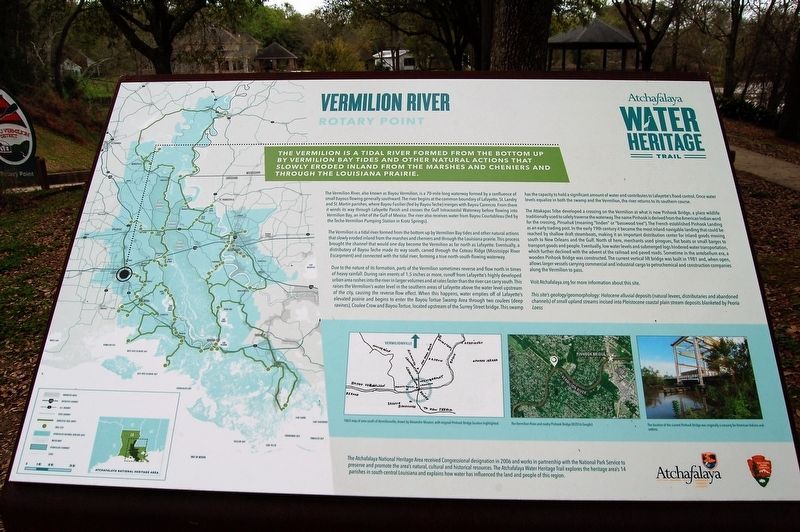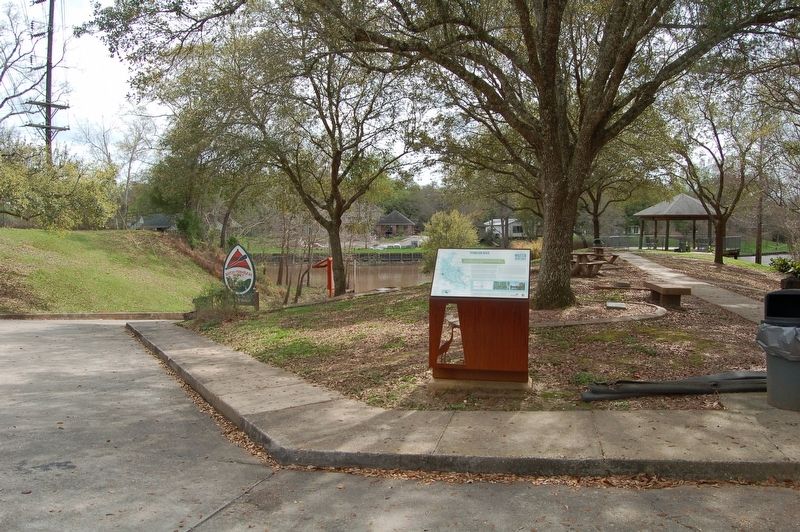Vermilion River
Rotary Point
— Atchafalaya Water Heritage Trail —
The Vermilion is a tidal river formed from the bottom up by Vermilion Bay tides and other natural actions that slowly eroded inland from the marshes and cheniers and through the Louisiana prairie.
The Vermilion River, also known as Bayou Vermilion, is a 70-mile-long waterway formed by a confluence of small bayous flowing generally southward. The river begins at the common boundary of Lafayette, St. Landry and St. Martin parishes, where Bayou Fusilier (fed by Bayou Teche) merges with Bayou Carencro. From there it winds its way through Lafayette Parish and crosses the Gulf Intracoastal Waterway before flowing into Vermilion Bay, an inlet of the Gulf of Mexico. The river also receives water from Bayou Courtableau (fed by the Teche-Vermilion Pumping Station in Krotz Springs).
The Vermilion is a tidal river formed from the bottom up by Vermilion Bay tides and other natural actions that slowly eroded inland from the marshes and cheniers and through the Louisiana prairie. This process brought the channel that would one day become the Vermilion as far north as Lafayette. Eventually, a distributary of Bayou Teche made its way south, carved through the Coteau Ridge (Mississippi River Escarpment) and connected with the tidal river, forming a true north-south-flowing waterway.
Due to the nature of its formation, parts
of the Vermilion sometimes reverse and flow north in times of heavy rainfall. During rain events of 1.5 inches or more, runoff from Lafayette’s highly developed urban area rushes into the river in larger volumes and at rates faster than the river can carry south. This raises the Vermilion’s water level in the southern areas of Lafayette above the water level upstream of the city, causing the reverse-flow effect. When this happens, water empties off of Lafayette’s elevated prairie and begins to enter the Bayou Tortue Swamp Area through two coulees (deep ravines), Coulee Crow and Bayou Tortue, located upstream of the Surrey Street bridge. This swamp has the capacity to hold a significant amount of water and contributes to Lafayette’s flood control. Once water levels equalize in both the swamp and the Vermilion, the river returns to its southern course.The Attakapas Tribe developed a crossing on the Vermilion at what is now Pinhook Bridge, a place wildlife traditionally used to safely traverse the waterway. The name Pinhook is derived from the American Indian word for the crossing, Pinsahuk (meaning “linden” or “basswood tree”). The French established Pinhook Landing as an early trading post. In the early 19th century it became the most inland navigable landing that could be reached by shallow draft steamboats, making it an important distribution center
for inland goods moving south to New Orleans and the Gulf. North of here, merchants used pirogues, flat boats or small barges to transport goods and people. Eventually, low water levels and submerged logs hindered water transportation, which further declined with the advent of the railroad and paved roads. Sometime in the antebellum era, a wooden Pinhook Bridge was constructed. The current vertical lift bridge was built in 1981 and, when open, allows larger vessels carrying commercial and industrial cargo to petrochemical and construction companies along the Vermilion to pass.Visit Atchafalaya.org for more information about this site.
This site’s geology/geomorphology: Holocene alluvial deposits (natural levees, distributaries and abandoned channels) of small upland streams incised into Pleistocene coastal plain stream deposits blanketed by Peoria Loess
Erected by State of Louisiana and National Park Service.
Topics and series. This historical marker is listed in these topic lists: Environment • Waterways & Vessels. In addition, it is included in the Atchafalaya Water Heritage Trail series list.
Location. 30° 11.626′ N, 92° 1.719′ W. Marker is in Lafayette, Louisiana, in Lafayette Parish. Marker is at the intersection
Other nearby markers. At least 8 other markers are within 2 miles of this marker, measured as the crow flies. Bayou Vermilion (approx. ¾ mile away); James Domengeaux (approx. 0.9 miles away); Concentrated Solar Power (CSP) Demo Unit (approx. 1.2 miles away); Solar Thermal Applied Research and Testing (START) Lab (approx. 1.2 miles away); Green Infrastructure & Urban Prairie (approx. 1.2 miles away); McNaspy Stadium Memorial (approx. 1.3 miles away); Eddy and Ann Knight (approx. 1.3 miles away); Amédé Ardoin / Dennis McGee (approx. 1.3 miles away). Touch for a list and map of all markers in Lafayette.
More about this marker. Located at the Rotary Point Boat Ramp.
Credits. This page was last revised on January 26, 2024. It was originally submitted on March 1, 2018, by Cajun Scrambler of Assumption, Louisiana. This page has been viewed 748 times since then and 39 times this year. Photos: 1, 2. submitted on March 1, 2018.

